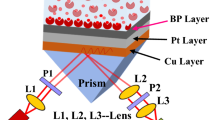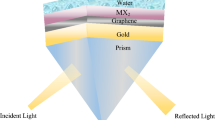Abstract
The main role of blood plasma is to transport proteins, hormones, and nutrients to certain parts of the body. All blood constituents are carried by blood plasma through the circulatory system. Cells get rid of waste products into the plasma. In this paper, we present a surface plasmon resonance (SPR) biosensor based on a black phosphor (BP) layer to improve the sensor performance. The black phosphor layer is employed as an interacting medium with the sensing medium for the improvement of the sensor sensitivity. The sensor is employed for the detection of blood plasma. Four metals are used: silver (Ag), gold (Au), copper (Cu), and aluminum (Al). We found that structures with the BP layer have better performance than those without a BP layer. Cu-structure has shown the highest sensitivity while the Ag-structure has shown the highest quality factor and detection accuracy and the lowest FWHM. As the concentration of the plasma increases, the sensitivity can be enhanced.















Similar content being viewed by others
Availability of Data and Material
Detail about data has been provided in the article.
Code Availability
The used code can be obtained from the corresponding author upon request.
References
Liedberg B, Nylander C, Sundstrom I (2005) Surface plasmon resonance for gas detection andiosensing. Sens Actuators B Chem 4:299–304
Jorgenson RC, Yee SS (1993) A fiber-optic chemical sensor based on surface plasmon resonance. Sens Actuators B Chem 12:213–220
Yupapin P, Trabelsi Y, Vigneswaran D, Taya SA, Daher MG, Colak I (2022) Ultra-high-sensitive sensor based on surface plasmon resonance structure having Si and graphene layers for the detection of chikungunya virus. Plasmonics. https://doi.org/10.1007/s11468-022-01631-w
Srivastava T, Purkayastha A, Jha R (2016) Graphene based surface plasmon resonance gas sensor for terahertz. Opt Quant Electron 48:334
Kretschmann E, Reather H (1968) Radiative decay of non-radiative surface plasmons excited by light. Z Naturforsch 23:2135–2221
Maurya JB, Prajapati YK (2016) A comparative study of different metal and prism in the surface plasmon resonance biosensor having MoS2-graphene. Opt Quant Electron 48:280
Maharana PK, Bhardwaj S, Jha R (2013) Electric field enhancement in surface plasmon resonance bimettalic configuration based on chalcogenide prism. J Appl Phys 114:014304
Daher MG, Taya SA, Colak I, Patel S, Olaimat MM, Ramahi O (2022) Surface plasmon resonance biosensor based on graphene layer for the detection of waterborne bacteria. J Biophotonics 15:e202200001
Li L, Yu Y, Ye GL, Ge Q, Ou X, Wu H, Feng D, Chen XH, Zhang Y (2014) Black phosphorus field-effect transistors. Nat Nanotechnol 9:372–377
Qiao J, Kong X, Hu ZX, Yang F, Ji W (2014) High-mobility transport anisotropy and linear dichroism in few-layer black phosphorus. Nat Commun 5:4475
Rodin AS, Carvalho A, Castro Neto AH (2014) Strain-induced gap modification in black phosphorus. Phys Rev Lett 112:176801
Wang X, Jones AM, Seyler KL, Tran V, Jia Y, Zhao H, Wang H, Yang L, Xu X, Xia F (2014) Highly anisotropic and robust excitons in monolayer black phosphorus. Nat Nanotechnol 10:517–521
Taya SA, Al-Ashi NE, Ramahi OM, Colak I, Amiri IS (2021) Surface plasmon resonance-based optical sensor using a thin layer of plasma. J Opt Soc Am B 38:2362–2367
Mao N, Tang J, Xie L, Wu J, Han B, Lin J, Deng S, Ji W, Xu K, Liu K, Tong L, Zhang J (2016) Optical anisotropy of BP in the visible regime. J Am Chem Soc 138:300–305
Verma VK, Pal S, Rizal C, Prajapati YK (2022) Tunable and sensitive detection of cortisol using anisotropic phosphorene with a surface plasmon resonance technique: numerical investigation. Magnetochemistry 8:31
Verma A, Sharma AK, Prajapati YK (2021) Simulation and analysis of SPR-based biosensor with borophene and antimonene layers. Opt Mater 119:111355
Sadeghi Z, Hajiani T, Shirkani H (2022) Optical properties of anisotropic phosphorene-graphene nanotubes and their application as label-free SPR biosensors in IR. Mater Sci Eng B 278:115615
Singh MK, Pal S, Verma A, Mishra V, Prajapati YK (2021) Sensitivity enhancement using anisotropic black phosphorus and antimonene in bi-metal layer-based surface plasmon resonance biosensor. Superlattices Microstruct 156:106969
Cho SY, Prajapati Y, Singh V, Saini J, Tripathi R (2016) Superior chemical sensing performance of black phosphorus: comparison with MoS2 and graphene. Adv Mater 28:7020–7028
Pal S, Verma A, Prajapati YK, Saini JP (2017) Influence of black phosphorous on performance of surface plasmon resonance biosensor. Opt Quant Electron 49:403
Khandelwal A, Mani H, Karigerasi MH, Lahiri I (2017) Phosphorene–the two-dimensional black phosphorous: properties, synthesis and applications. Mater Sci Eng B 221:17–34
Yasaei P, Behranginia A, Foroozan T, Asadi M, Kim K, Araghi FK, Khojin AS (2015) Stable and selective humidity sensing using stacked black phosphorus flakes. ACS Nano 9:9898–9905
Singh Y, Raghuwanshi SK (2019) Sensitivity enhancement of the surface plasmon resonance gas sensor with black phosphorus. IEEE Sens Lett 3:1–4
Kumar V, Brent JR, Shorie M, Kaur H, Chadha G, Thomas AG et al (2016) Nanostructured aptamer-functionalized black phosphorus sensing platform for label-free detection of myoglobin, a cardiovascular disease biomarker. ACS Appl Mater Interfaces 8:22860–22868
Wood JD, Wells SA, Jariwala D, Chen K-S, Cho E, Sangwan VK et al (2014) Effective passivation of exfoliated black phosphorus transistors against ambient degradation. Nano Lett 14:6964–6970
Lee HU, Park SY, Lee SC, Choi S, Seo S, Kim H et al (2016) Black phosphorus (BP) nanodots for potential biomedical applications. Small 12:214–219
Srivastava T, Jha R (2018) Black phosphorus: a new platform for gaseous sensing based on Surface Plasmon Resonance. IEEE Photonics Technol Lett 30:319–322
Elias DC, Gorbachev RV, Mayorov AS, Morozov SV, Zhukov AA, Blake P, Ponomarenko LA, Grigorieva IV, Novoselov KS, Guinea F, Geim AK (2011) Dirac cones reshaped by interaction effects in suspended graphene. Nat Phys 7:701–704
Panda A, Pukhrambam PD, Keiser G (2020) Performance analysis of graphene-based surface plasmon resonance biosensor for blood glucose and gas detection. Appl Phys A 126:1–12
Pal S, Verma A, Saini JP, Prajapati YK (2019) Sensitivity enhancement using silicon black phosphorous–TMDC coated surface plasmon resonance biosensor. IET Optoelectron 13:196–201
Almawgani A, Taya SA, Daher MG, Colak I, Wu F, Patel SK (2022) Detection of glucose concentration using a surface plasmon resonance biosensor based on barium titanate layers and molybdenum disulphide sheets. Phys Scr 97:065501
Wu L, Chu HS, Koh WS, Li EP (2010) Highly sensitive graphene biosensors based on surface plasmon resonance. Opt Express 18:14395–14400
Rahman MS, Anower MS, Rahman MK, Hasan MR, Hossain MB, Haque MI (2017) Design and numerical analysis of highly sensitive Au-MoS2-graphene based hybrid surface plasmon resonance biosensor. Opt Commun 396:36–43
Kushwaha AS, Kumar A, Kumar R, Srivastava SK (2018) A study of surface plasmon resonance (SPR) based biosensor with improved sensitivity. Photonics Nanostruct Fundem Appl 31:99–106
Rahman MS, Anower MS, Rahman MK, Hasan MR, Hossain MB, Haque MI (2017) Modeling of a highly sensitive MoS2-Graphene hybrid based fiber optic SPR biosensor for sensing DNA hybridization. Optik 140:989–997
Hossain MB, Mehedi IM, Moznuzzaman M, Abdulrazak LF, Hossain MA (2019) High performance refractive index SPR sensor modeling employing graphene tri sheets. Results Phys 15:102719
Funding
The authors are thankful to the Deanship of Scientific Research at Najran University for funding this work under the Research Groups Funding program grant code (NU/RG/SERC/11/16).
Author information
Authors and Affiliations
Contributions
All authors contributed to the study conception and design. Mathematical derivation and part of the editing were performed by Abdulkarem H. M. Almawgani and Malek G. Daher. The code and part of the editing were performed by Sofyan A. Taya and Melad M. Olaimat. The first draft of the manuscript was written by Adam R. H. Alhawari and Ilhami Colak. Discussion of the results was performed by Sofyan A Taya. All authors commented on previous versions of the manuscript. All authors read and approved the final manuscript.
Corresponding author
Ethics declarations
Competing interests
The authors declare no competing interests.
Ethics Approval
This study does not require ethics approval.
Consent to Participate
No consent to participate is required for this study.
Consent for Publication
No consent for publication is required for this study.
Conflict of Interest
The authors declare no competing interests.
Additional information
Publisher's Note
Springer Nature remains neutral with regard to jurisdictional claims in published maps and institutional affiliations.
Rights and permissions
About this article
Cite this article
Almawgani, A.H.M., Daher, M.G., Taya, S.A. et al. Detection of Blood Plasma Concentration Theoretically Using SPR-Based Biosensor Employing Black Phosphor Layers and Different Metals. Plasmonics 17, 1751–1764 (2022). https://doi.org/10.1007/s11468-022-01662-3
Received:
Accepted:
Published:
Issue Date:
DOI: https://doi.org/10.1007/s11468-022-01662-3




